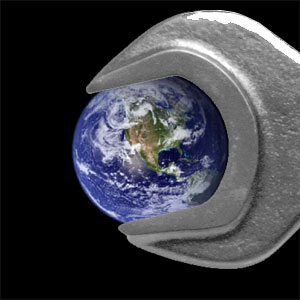
Among scientists, geoengineering tends to be greeted with mirth and scorn. Implying that we can reliably manipulate the planet’s life-support systems seems to many to be the classic definition of hubris – “presumption towards the gods.” Almost all climate scientists, even those that research geoengineering, advocate for cutting emissions.
But, of course, cutting emissions is hard and expensive, and no one really wants to do it. Having a technical solution would be a great political tool, and instituting it seems straightforward compared to rebuilding the entire world’s infrastructure. So geoengineering (and the associated hubris) are gaining traction in political circles. For example, the climate-science-challenged economists who authored Superfreakonomics boasted “Once you eliminate the moralism and the angst, the task of reversing global warming boils down to a straightforward engineering problem.”
Unfortunately the oceans bear the brunt of the risk for most geoengineering schemes. In an article that appeared today in Slate Magazine, Jeff Goodell, the author of How to Cool the Planet: Geoengineering and the Audacious Quest to Fix Earth’s Climate divides geoengineering into two main categories: those that would reduce sunlight coming to the earth and those that would remove carbon from the air.

If we reduced sunlight coming to the earth but did not reduce carbon emissions, ocean acidification would continue unabated. (I’m not considered the many other potentially dangerous consequences of dumping particles into the high atmosphere). Ocean acidification is a reaction between ocean water and atmospheric carbon dioxide – it would not be mitigated by blocking sunlight. And by decreasing the pH of the ocean, we would endanger the many thousands of species that depend on calcium carbonate structures to make a living, including corals, shellfish, and even phytoplankton. For an excellent primer on ocean acidification, see Sheril Kirshenbaum’s Ocean Acidification 101.
Removing carbon from the atmosphere would help the ocean acidification issue, but the most commonly discussed method for doing this is ocean fertilization. This involves adding nutrients to the ocean to induce phytoplankton to bloom and suck carbon out of the atmosphere. The phytoplankton would then die and sink and take their carbon to the deep sea, there to be stored forever. At least, that’s the idea.
Along with Dr. M and Rick, I cut my blogular teeth on the fly-by-night Planktos, which wanted to sell carbon credits by fertilizing the Pacific with iron. While Planktos wasn’t a well-run operation, large-scale ocean fertilization remains dubious because it is irreversible, poorly understood, and has a very high likelihood of unexpected side effects. Oh, yeah, and there’s little evidence that it works. Just last year, an iron fertilization experiment completely failed when all the phytoplankton were slurped by grazing copepods which then got crunched by predatory amphipods, resulting in very little carbon sequestration. Another reason that large-scale ocean fertilization is a bad idea is because the deep sea is not a locked box – if you learn nothing else from reading this blog, we hope you know that stuff is alive down there. Carbon sequestered in the deep sea may not stay sequestered forever.
Last spring, Chris Mooney called for scientists to help mold the public discourse on geoengineering.
People may be malleable and uninformed on this subject now, but the more they hear–and especially if some major controversy erupts–the more they will firm up their minds. This suggests to me that scientists ought to get out in front of this opinion-forming process now, rather than later.
Mooney was concerned that activists would cause geoengineering to be prematurely banned, while I am afraid that it will be prematurely begun. Nonetheless, the point is the same. Geoengineering is already on the table, and it is critical that the true costs and benefits be considered. As any ecologist can tell you, we should not accidentally make things worse while trying to fix the errors of the past.
Goodell’s article in Slate was part of a special issue on geoengineering published in advance of next week’s Future Tense conference. This conference will seriously consider whether geoengineering is a viable solution to climate change. From the conference website:
Is it time for humanity to go on offense against global warming? Can we? Should we? Curtailing economic activity, altering lifestyles and well-intentioned talk in Copenhagen has not accomplished much. That’s why serious people are now considering Plan B, to intentionally tinker with the planet’s climate to correct for industrialization-induced warming. The hubris of “hacking the planet” is astounding, as are the implications for everything from military strategy to agriculture.
While the conference is primarily comprised of academics, it also includes Congressman Bart Gordon, Chairman of the House Committee on Science and Technology. It does not include any ocean scientists on the agenda, though I hope there will be some in attendance.
Some kind of geoengineering may very well be part of the solution to our climate woes. As Goodell points out, we are currently geoengineering the planet by accident – changing the albedo and adding all kinds of things to the atmosphere and warping the entire water cycle. However, we got ourselves into this mess by doing irreversible things to the planet without adequately considering the cost. Ocean scientists need to be at the forefront of geoengineering considerations, making sure that decision makers don’t forget about the health and welfare of 70% of the earth’s surface. And hopefully in the future, that will include participating in meetings like Future Tense.






2 Replies to “Why ocean scientists can’t ignore geoengineering”
Comments are closed.